- Why You Need a Job Description Revision Tracker (Before Your Next Audit) - January 9, 2026
- 20+ Helpful Recruitment Advertising Agencies (2026) - January 5, 2026
- 16 Helpful Career Site Self-Service Tools for You - December 18, 2025
Using inclusive language is one of the top best practices in writing job descriptions. It improves your chances to attract diversity as well as the best candidates because it widens the net to include as many qualified candidates as possible.
What is inclusive language? Hubspot, in its great article How to Use & Promote Inclusive Language at Your Organization, put it this way:
“Inclusive language avoids biases, slang, or expressions that discriminate against groups of people based on race, gender, or socioeconomic status. Inclusive language allows you to resonate with more audiences by speaking and writing in more impartial ways.”
Here are 6 tips for using inclusive language to attract a more diverse candidate pool. They go far beyond just creating gender-inclusive job descriptions.
1. Create a Diversity Style Guide of Inclusive Language
First off, you’re going to want to create an inclusive language guide (aka “Diversity Style Guide”) for your recruiting team. You can review other style guides as a starting point.
The goal of this inclusive language style guide is:
- to allow people to look for more info or advice when unsure about which words to use
- to combat the use of discriminatory language (aka “non-inclusive language”) in your internal and external communications
- to help people use “use examples that reflect a broad range of identities and perspectives” when writing speaking, or using images
A diversity style guide outlines inclusive words and highlights terms that might make some people feel excluded. Here are some examples of recommendations around race and ethnicity from SumOfUs.org’s A Progressive’s Style Guide:
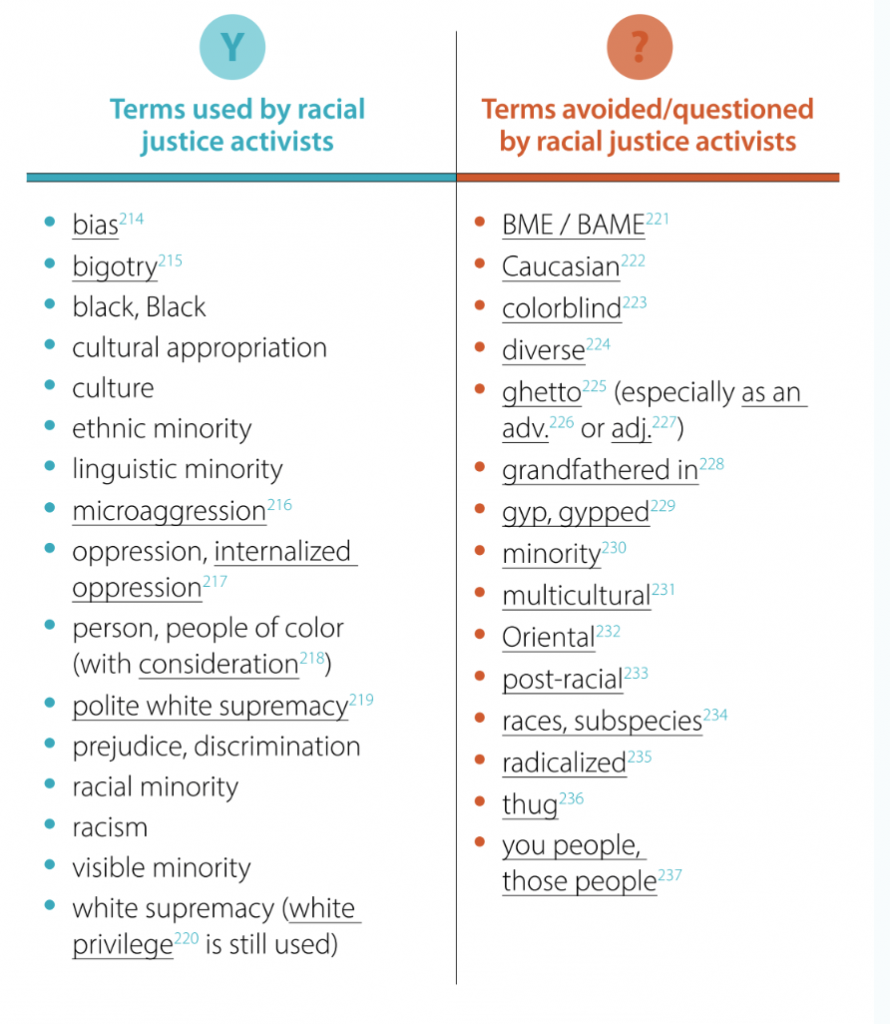
Creating an inclusive language list supports your recruiters and hiring managers when they craft job postings. With robust, DEI-informed resources, your team can more effectively hire people from a variety of backgrounds.
Having a “biased words list” (e.g. the “Terms Avoided” list above) along with terms that are ok (the ones on the left above) help keep biased language from making its way into your job ads. Many organizations, such as those we highlight below, use lists like these to encourage and support inclusive language.
In 2020, Twitter Engineering tweeted with the #WordsMatter hashtag when they announced their internal inclusive language list.
Inclusive language plays a critical role in fostering an environment where everyone belongs. At Twitter, the language we have been using in our code does not reflect our values as a company or represent the people we serve. We want to change that. #WordsMatter https://t.co/JVO8968B7K
— Twitter Engineering (@TwitterEng) July 2, 2020
Along with Twitter, other companies followed this trend for things like racially-coded language. According to CNET, Apple removed non-inclusive language like “blacklists” and “master/slave” from their content and created alternatives in their updated style guide. Following activism by the Black Lives Matter movement, Microsoft replaced some racially-coded language and created and internal style guide suggesting inclusive language synonyms for employees.
Google’s inclusive language style guide for developers mentions avoiding “unnecessarily gendered language.”
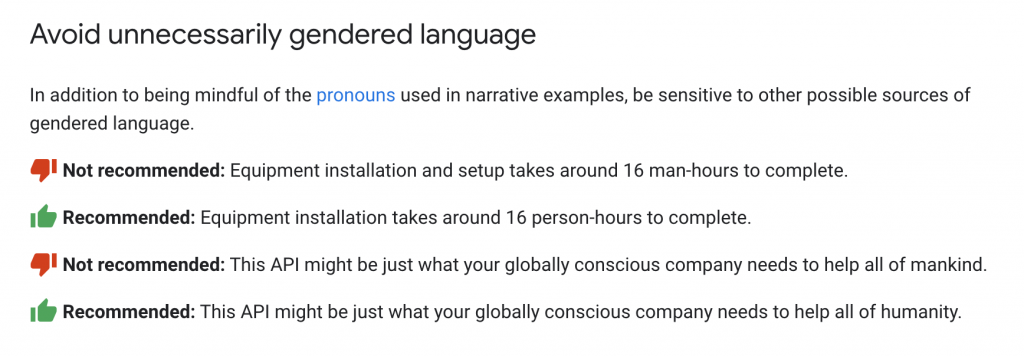
If you create an inclusive/progressive style guide, your team is more likely to use inclusive language in hiring, interviewing, and at work in general. The language we use shapes our attitudes, culture, and experiences. Building a more inclusive work culture starts with inclusive language. For more ideas of how you can use language lists to improve hiring outcomes, check out this list of the 75 most common biased words and phrases in job descriptions and some simple, inclusive replacements.
2. Avoid common jargon and complex phrases
Job ads that contain industry jargon or needlessly complex language can discourage some potential candidates from applying.
Did you know that candidates on the autism spectrum take things more literally than those not on the spectrum? Respect the beauty of neurodiversity and use language that prioritizes clarity over cleverness.
A few examples:
- replace “low hanging fruit” with “simple tasks”
- use “pioneer” instead of “push the envelope”
- don’t use “zero-sum-game”
Neurodiversity is a broad term that includes candidates with many different abilities and life experiences. Candidates with ADHD, for example, may struggle focusing on a job description that is lengthy instead of concise.
Try cutting back on multi-syllable words to shorten and clarify your job descriptions.
- Replace “In accordance with” with “by” or “under” are easier to read
- Replace “In order to” — with “to”
- Replace “liaise with” with “work with”
And beware acronyms!
Acronyms like KPIs, SLAs, and P&L can also be hard to understand. Spell them out, or leave them out.
You can make major progress with diversity language in your JDs just by keeping things simple.
Use a simple sentence like this:
“Seeking an entry-level assistant to support the buying process, helping our team meet goals and deliver on our promises to customers.” — Linkedin Talent
Instead of a more clever/but hard-to-read sentence like this:
“Seeking a superstar who can liaise with the procurement team and push the envelope in order to deliver on our promises to customers.” — Ongig
Avoid industry jargon and corporate language — not only can it cause problems for neurodiverse candidates, it’s also a big barrier that keeps talented young people from applying to entry-level positions. Candidates with experience may understand what you mean by these phrases, but young candidates or candidates who speak English as a second language might feel excluded or confused.
3. Use a job description tool that removes non-inclusive language
How do you know if you are using inclusive language in your job descriptions? Find a tool that highlights non-inclusive language and gives more inclusive replacements. Using a job description tool like Ongig’s Text Analyzer helps you find masculine-coded words and other types of biased language (race, disability, age, sexual orientation, mental health, and more) in your job descriptions.
The screenshot below shows a Database Engineer job description in Text Analyzer with more inclusive replacement phrases for masculine-coded words like “strong” and “leader”:
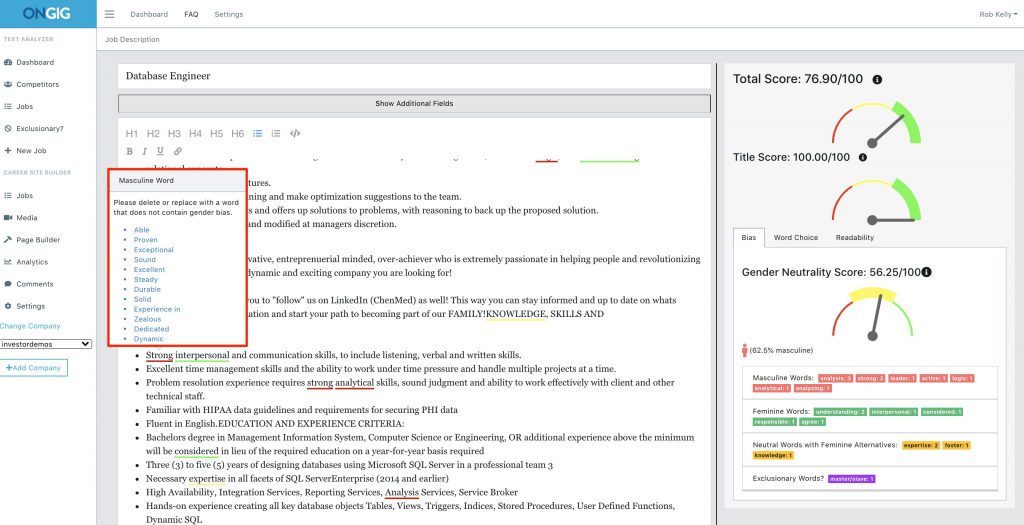
This screenshot of an Executive Assistant job ad shows more inclusive replacement phrases for “grandfathered” — a term with racist origins and overtones:
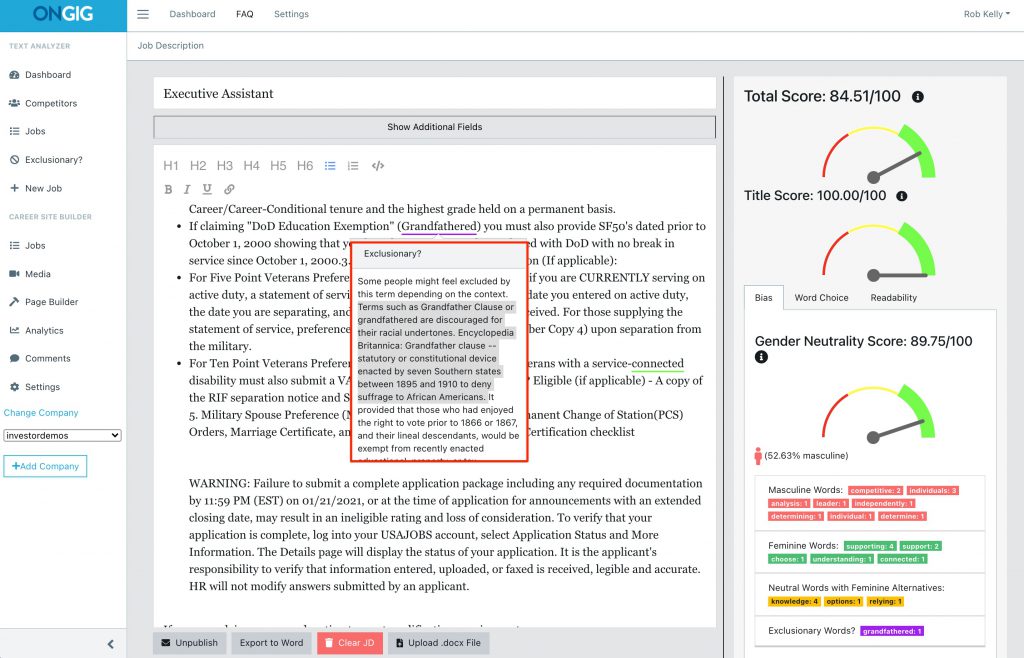
While we encourage everyone to stay up-to-date on inclusive language to communicate more effectively, tools like Text Analyzer can ensure that we don’t overlook any problematic language due to our unconscious biases and lived experiences. It helps to have a program that can double-check your work for inclusivity. Many organizations also use our Text Analyzer because it offers the ability to set and lock-in an inclusive language style guide for your whole organization.
In our blogs, 7 Examples of LGBTQ Exclusionary Language [in Job Descriptions] and Top 10 Terms with Bias Toward POC [in Job Descriptions], there are more examples of non-inclusive language that a job description tool like Text Analyzer helps you flag and replace.
4. Use dyslexia-friendly fonts to be more inclusive to “neurodivergent” candidates
Being inclusive in your job description language also means considering neurodiverse candidates. It’s estimated that 1 in 10 people in the U.S. have dyslexia. People with dyslexia (sometimes known as “neurodivergent people”) may have challenges processing words on a screen. This means understanding font choices in job descriptions are important if you want to be more inclusive.
The British Dyslexia Association even has a Dyslexia friendly style guide with tips. Here are a few of the many ideas listed in their diversity style guide:
- changing the font makes inclusive job descriptions easier to read (Arial, Comic Sans, Verdana, Tahoma, Century Gothic, Trebuchet, Calibri, or Open Sans are all considered dyslexic-friendly fonts)
- clearly format text using subheadings
- underlining text or italics causes crowding; use bold for emphasis instead
- using a larger dyslexia friendly font size (12-14 point)
Here’s an example. The job posting below is for an HR Business Consultant. The content in both is the same, but the image on the left is not dyslexia-friendly. The image on the right uses dyslexia friendly fonts and more inclusive formatting.
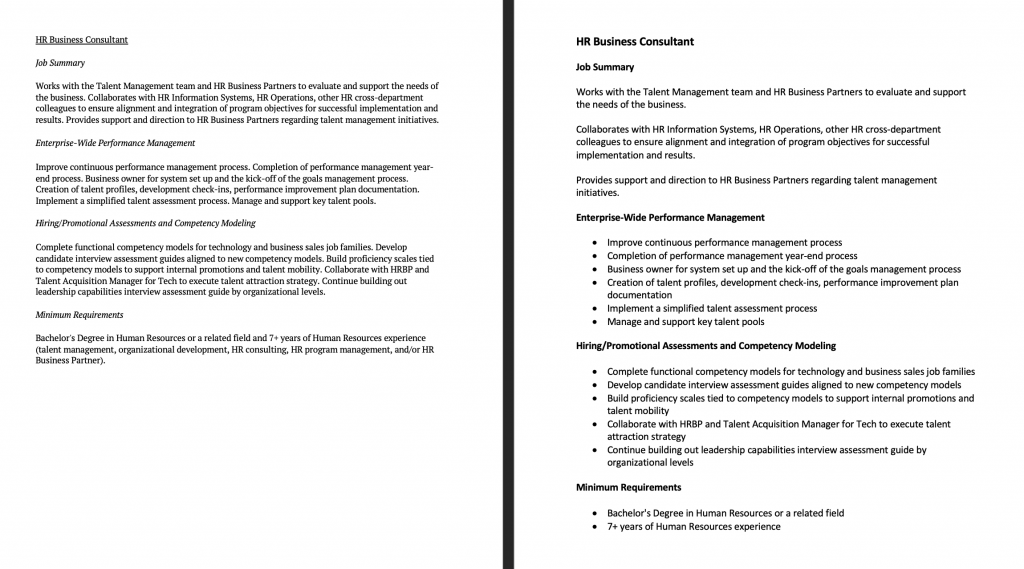
You can also create more dyslexia-friendly job descriptions by writing clearly, using high-contrast colors for text, and avoiding abbreviations or jargon.
5. Inclusive Language for People with Disabilities
Another tip: don’t use unnecessary details where you don’t have to. This not only helps simplify your job descriptions for people with dyslexia, but it also lowers the chances of excluding certain groups, like people with disabilities.
“For example, you might write that a plant manager needs to walk from station to station. But is the method of getting from one place to another really important? Couldn’t an employee use a wheelchair or scooter to achieve the goal?”– Understood’s blog Rethinking “essential functions”: 5 ways to make job descriptions more inclusive
Using words like “lift” might make someone feel excluded depending on the context. As Understood’s blog suggests, review the physical requirements in your job descriptions. Are they truly required, or could a person with disabilities accomplish their job duties in another way or with accommodations?The image below shows some more inclusive replacements that could also prevent an ADA lawsuit:
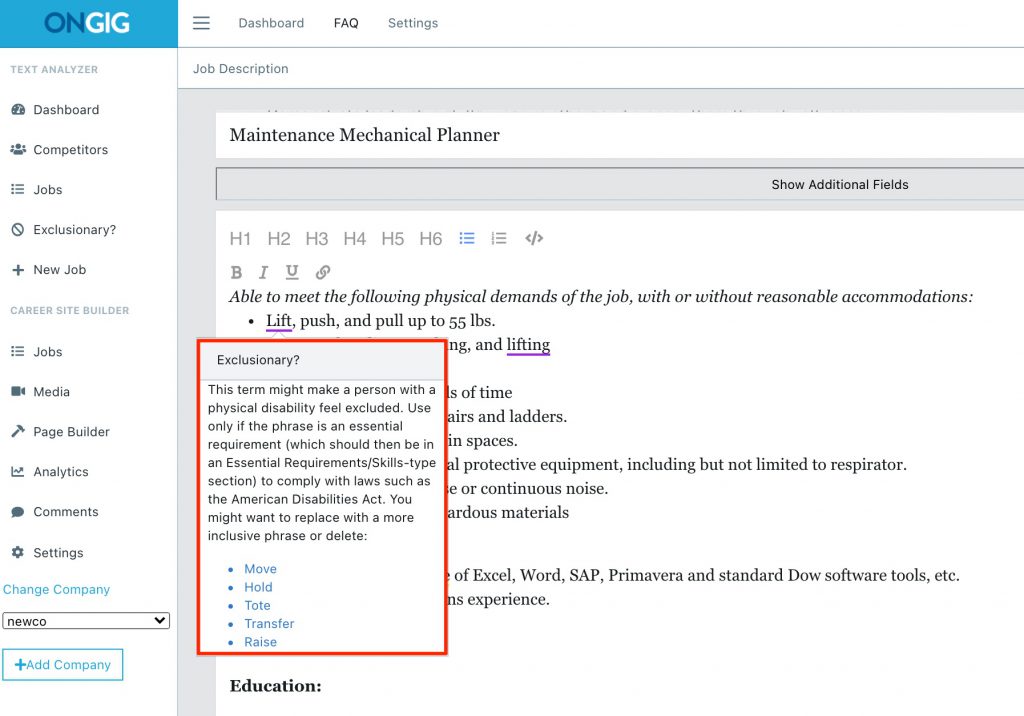
There are other ways to use language that includes people with disabilities in your job descriptions. Many words in our everyday speech contain negative bias toward people with disabilities. Here is a list of some of the words that may be offensive to disabled folks and a list of neutral alternatives.
6. Highlight “Inclusive Benefits” in your job descriptions
Another tip, show candidates your company is dedicated to being inclusive. Add a special sentence or paragraph in your job postings highlighting things like:
- employee benefits for underrepresented groups (e.g., a mentor program for people of color)
- your organization’s commitment to DEI (e.g., an internal DEI committee, other accountability measures)
- employee resource groups (ERGs) supporting inclusion (e.g., list the # of ERGS you have)
- diversity training for employees (e.g., annual unconscious bias training sessions)
- flexibility and needs accommodations (e.g., flexible work arrangements for parents or people with disabilities)
Include this information anywhere in the job description. Here are a few examples of language companies are using to be more inclusive:
Entrust Datacard
The intro section of Entrust’s Business Systems Analyst job posting says:
“From unconscious bias training for managers to global affinity groups that create connections both within and across our enterprise, Entrust expects and encourages all individuals to accept and respect one another. And, of course, to be themselves.”
Federal Reserve Bank of Philadelphia
In the closing section of this bank’s Support Analyst job ad, we found this:
“To support a workplace culture of belonging, we offer seven employee resource groups (ERGs) and a 100 percent rating on the Human Rights Campaign (HRC) Corporate Equality Index.”
You can also add some of these to your EEO Statement at the end of your inclusive job postings. See below for more examples like this.
7. Use Inclusive Language in the EEO Statement of your Job Posting
EEO statements are not new, but they can be polished, with a focus on being inclusive. Here are 2 examples (one short and lone longer) of companies using inclusive language in their EEO statement:
Survey Monkey
“SurveyMonkey is an equal opportunity employer. We celebrate diversity and are committed to creating an inclusive environment for all employees.”
Visa
“Universal acceptance for everyone, everywhere is at the heart of our company. We promote diversity of thought, culture and background, which connects the entire Visa family. As such, Visa is proud to be an Equal Opportunity Employer. We do not discriminate on the basis of race, color, ancestry, national origin, religion or religious creed, mental or physical disability, medical condition, genetic information, sex (including pregnancy, childbirth, and related medical conditions), sexual orientation, gender identity, gender expression, age, marital status, military or veteran status, citizenship, or other characteristics protected by state or federal law or local ordinance.”
And double-check progressive style guides to make sure that your EEO does not contain non-inclusive language.
You can find more examples of EEOs in 10 Samples of an Effective EEO Statement.
8. Create web content that is compatible with screen readers and other visual assistive technology
To create truly inclusive job descriptions, ensure that they are accessible for people of all backgrounds, including to people with disabilities. We’ve already reviewed some of the ways you can be more inclusive to neurodiverse candidates, such as those with ADHD and dyslexia. But what about the nearly eight million Americans with blindness, low vision, or vision impairment?
Many people rely on assistive technology to help them navigate the internet (and thereby to navigate the job application process). For example, blind people may use screen readers, a form of technology that converts digital content into audio. There are many types of assistive technology that blind and visually impaired people use to navigate the job application process. Job descriptions with abnormal formatting, or that lack alt text for images, can create unnecessary barriers for candidates with some form of vision impairment.
Not sure where to start with creating more accessible job descriptions? Services such as AudioEye use AI-powered technology, as well as consult with disabled people, to ensure that websites are compatible with a variety of assistive technologies.
9. Audit your candidate ‘must-haves’ for bias
Candidate must-haves are a common feature of job descriptions. A list might look like this:
- Candidate must have a 3.5 GPA from an elite college (Ivy League preferred).
- A strong candidate will be a driven salesman, committing to aggressively pursuing leads and closing deals.
- Candidate must have between five and 12 years of experience.
- Candidate must be able to lift up to 50 pounds and stand for eight hours.
The trouble with candidate requirements is that they often reinforce and perpetuate insidious forms of discrimination and bias.
- Requiring a high GPA, or attendance of a certain university, is elitist and classist.
- Masculine-coded language such as “strong”, “salesman”, “aggressive”, and “pursuing” subtly indicates that women are unwelcome.
- Listing a required range of years of experience excludes both younger and older candidates. Candidates over 40 are protected by law against age-related employment discrimination in the United States.
- Physical requirements are often included by default, without any real thought to whether they are necessary. These requirements may unnecessarily exclude disabled people.
10. Include LGBTQ+ folks with gender-neutral language
Review the language of your job descriptions for LGBTQ+ inclusivity. Here are a few ideas to consider:
- Use unbiased language. Work with a job description tool like OnGig’s Text Analyzer to scan content for gender bias. Too much masculine-coded language could prevent women from applying, and the same goes for feminine-coded language.
- Default to gender-neutral language when referring to marriage. Consider using “spouse” or “partner”, both of which are gender-neutral and inclusive alternatives to “husband” and “wife”.
- Share your leave policies, including whether you offer parental leave (rather than just maternity leave), adoption leave, or insurance coverage for fertility treatments.
- This ought to go without saying, but don’t use language that is discriminatory or biased against the queer community. Do your research on current language preferences.
- Set an example by voluntarily including your pronouns on your LinkedIn profile and in your email signature, if you’re comfortable with it. When you interact with potential candidates online or via email, this shows that you’re ready to respect others’ preferred pronouns and identity.
Why I Wrote This:
The team here at Ongig is on a mission to help eliminate boring and biased job content. Using inclusive language in job descriptions is a top priority for many companies. Ongig’s Text Analyzer job description tool helps support the creation of inclusive job postings.
Shout-Outs:
- What is Inclusive Language? (by dictionary.com)
- A Progressive’s Style Guide (by Hanna Thomas and Anna Hirsch)
- 6 Must-Know Tips for Writing Inclusive Job Descriptions (by Alexandra Johnson)
- Apple banishes ‘blacklist’ and ‘master branch’ in push for inclusive language (by Stephen Shankland)
- Four Ways to Make Job Descriptions More Inclusive (by Molly Brennan)
- 5 TIPS FOR WRITING INCLUSIVE JOB DESCRIPTIONS (by Danielle Gauthier)
- Rethinking “essential functions”: 5 ways to make job descriptions more inclusive (by Julie Rawe)
- 5 Must-Do’s for Writing Inclusive Job Descriptions (by Maxwell Huppert)
- 5 Tips for Writing Gender-Inclusive Job Descriptions (by Betsy Curtin)
- How to write more inclusive job descriptions (by Monster)
- Dyslexia Facts and Statistics (by Austin Learning Solutions)
- How to Use & Promote Inclusive Language at Your Organization (by Caroline Forsey)
- Dyslexia friendly style guide (by British Dyslexia Association)
- How to Write an Equal Opportunity Employer Statement That Draws Great Talent (by Fairygodboss)
